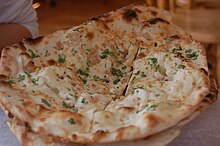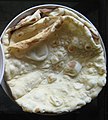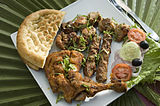Naan

 | |
| Alternative names | Nan, Noon, Paan, Faan |
|---|---|
| Region or state | Asia |
| Main ingredients | Flour, yeast, salt, sugar, ghee, water |
Naan (/nɑːn/) is a leavened, oven-baked or tawa-fried flatbread, that can also be baked in a tandoor. It is characterized by a light and fluffy texture and golden-brown spots from the baking process.[1] Naan is found in the cuisines of Central Asia, South Asia, Southeast Asia, and the Caribbean.[2][3][4]
Composed of white or wheat flour and combined with a leavening agent, typically yeast, naan dough develops air pockets that contribute to its fluffy and soft texture. Additional ingredients for crafting naan include warm water, salt, ghee and yogurt, with optional additions like milk, egg, or honey. Baking powder or baking soda can be used instead of yeast to reduce the preparation time for the bread.
In the baking process using a tandoor, naan dough is rolled into balls, flattened and pressed against the inner walls, which can reach temperatures up to 480 °C (900 °F). This method allows the bread to be baked within minutes, achieving a spotty browning due to intense heat. Naan can be prepared on a stovetop using a tava. The pan may be flipped upside down over the flame to achieve browning on the bread's surface.
Once baked, naan is coated with ghee or butter and served warm. This soft and pliable bread accompanies meals, replacing utensils for scooping up sauces, stews, and curries, or with dryer dishes like tandoori chicken. [5]
Etymology
[edit]
The term "naan" comes from Persian nân (Persian: نان), a generic word for any kind of bread.
The earliest known English use of the term occurs in an 1803 travelogue written by William Tooke.[6] While Tooke and other early sources spelled it "nan", the spelling "naan" has become predominant since the 1970s.[7][8]
Varieties
[edit]Indian subcontinent
[edit]Naan spread to the Indian subcontinent during the Islamic Delhi Sultanate period. The earliest mention of naan in the region comes from the memoirs of Indo-Persian Sufi poet Amir Khusrau living in India during the 1300s AD. Khusrau mentions two kinds of naan eaten by Muslim nobles; Naan-e-Tunuk and Naan-e-Tanuri. Naan-e-Tunuk was a light or thin bread, while Naan-e-Tanuri was a heavy bread and was baked in the tandoor.[9] During India’s Mughal era in the 1520s, naan was a delicacy that only nobles and royal families enjoyed because of the lengthy process of making leavened bread and because the art of making naan was a revered skill known by few. The Ain-i-Akbari, a record of the third Mughal emperor’s reign, refers to naan being eaten with kebabs or kheema in it. By the 1700s, naan had reached the masses in Mughal cultural centers in South Asia.[10]
Indonesia
[edit]In Indonesia, naan is a popular alternative to rice among the Indians, Arabs, Malays, Acehnese and the Minangkabaus, similar though not the same as roti or roti canai which was introduced from Tamils. This dish is known as roti naan or roti nan, and is cooked using Indonesian spices such as garlic.[11]
Myanmar
[edit]Naan bya (Burmese: နံပြား) in Myanmar is traditionally served at teahouses with tea or coffee as a breakfast item.[12] It is round, soft, and blistered, often buttered, or with creamy pè byouk (boiled chickpeas) cooked with onions spread on top, or dipped with Burmese curry.[12]
| External image | |
|---|---|
China
[edit]The Jingzhou style of guokui, a flatbread prepared inside a cylindrical charcoal oven much like a tandoor, has been described as "Chinese naan".[13] It is also an integral part of Uyghur cuisine and is known in Chinese as 馕 (náng).[14][15]
Japan
[edit]After being promoted by Kandagawa Sekizai Shoukou in 1968, which is now the sole domestic manufacturer of tandoors, naan is now widely available in Indian-style curry restaurants in Japan, where naan is typically free-flow. Some restaurants bake ingredients such as cheese, garlic, onions, and potatoes into the naan, or cover it with toppings like a pizza.[16][17][18]
Georgia
[edit]Shotis puri is a popular flat bread eaten in Georgia and cooked by sticking dough to the sides of a tandoor-like clay oven called a tone.
Elsewhere
[edit]In 1799, the word naan was introduced into the English language by historian and clergyman William Tooke. Today, naan can be found worldwide in restaurants serving South Asian and Middle Eastern cuisine, and it is available in many supermarkets. Fusion cuisine has introduced new dishes that incorporate naan, including naan pizza and naan tacos and even huevos rancheros (an egg dish) served over naan. Naan pizza is a type of pizza where naan is used as the crust instead of the traditional pizza dough. Chefs such as Nigella Lawson,[19] and supermarkets such as Wegmans[20] offer recipes for people to make their own naan pizza at home, though it is certainly not traditional.
Gallery
[edit]- Nan in Afghanistan
- Nan in Kabul, Afghanistan
- Nan in Mazar-e Sharif, Afghanistan
- Nan in Iran
- Nân-e barbari in Iran
- Nân-e sangak in Iran
- Nân-e tâftun in Iran
- Butter garlic naan
- Paneer (cheese) naan
- Burmese nan bya
See also
[edit]References
[edit]- ^ Bernard Clayton's New Complete Book of Breads By Bernard Clayton Jr., Donnie A Cameron. Simon and Schuster. 1987. ISBN 9780671602222.
- ^ Qmin Archived 24 April 2023 at the Wayback Machine by Anil Ashokan, Greg Elms
- ^ The Science of Cooking, Peter Barham, Springer: 2001. ISBN 978-3-540-67466-5. p. 118.
- ^ The Bread Lover's Bread Machine Cookbook Archived 24 April 2023 at the Wayback Machine by Beth Hensperger
- ^ "Naan | Description, History, Ingredients, Preparation, & Varieties | Britannica". Archived from the original on 28 March 2024. Retrieved 28 March 2024.
- ^ Russia, or a Complete Historical Account of all the Nations which compose that Empire, London, p. 168: "The most common dishes are onoschi, or vermicelli; plav, or boiled rice; nan, pancakes, and the meats which the law permits." (referring to the eating habits of the central Turks). Other attestations in English can be found in the Oxford English Dictionary, s.v. naan.
- ^ "Home : Oxford English" Dictionary". oed.com. Archived from the original on 29 April 2020. Retrieved 6 September 2015.
- ^ Milton Glaser and Jerome Snyder. "Delhi Delights", New York Magazine, August 11, 1975, p. 73
- ^ "History of Naan". Times of India. 11 June 2020. Archived from the original on 22 January 2023. Retrieved 22 January 2023.
- ^ Dash, MadhulIka (2015). "Breaking Bread" (PDF). No. May–June. Forbes life india. Forbes. Archived (PDF) from the original on 22 January 2023. Retrieved 22 January 2023.
- ^ "Baking with Eda: 'Naan' Indonesian Flatbread". Archived from the original on 26 October 2020. Retrieved 22 May 2020.
- ^ a b "Eating in Burma". Travelfish. Archived from the original on 29 May 2023. Retrieved 29 May 2023.
- ^ "This 1,000-Year-Old Chinese 'Naan' Was Once Cooked in a Hat, and It's Yummy". Archived from the original on 11 July 2021. Retrieved 3 July 2021.
- ^ "Uighur Nan with Cumin and Onion Recipe". Archived from the original on 4 February 2022. Retrieved 4 February 2022.
- ^ "Have You Ever Seen Uyghur Bazaar Naan? It's So Fluffy and Delicious | TRP". 6 May 2021. Archived from the original on 4 February 2022. Retrieved 4 February 2022.
- ^ "【近ごろ都に流行るもの】「カレーにナン」本場インド以上に普及・巨大化". 27 July 2018. Archived from the original on 18 January 2022. Retrieved 17 January 2022.
- ^ "インド人が驚く日本の「ナン」独自すぎる進化 | 食べれば世界がわかる!カレー経済圏". 6 May 2019. Archived from the original on 18 January 2022. Retrieved 17 January 2022.
- ^ "日本のインド料理店のナンが大きい理由 | 雑学ネタ帳". Archived from the original on 18 January 2022. Retrieved 17 January 2022.
- ^ Nigella. "NAAN PIZZA - Recipes - Nigella Lawson". nigella.com. Archived from the original on 9 September 2015. Retrieved 6 September 2015.
- ^ "Recipes - Wegmans". wegmans.com. Archived from the original on 1 May 2014. Retrieved 6 September 2015.
External links
[edit] Media related to Naan at Wikimedia Commons
Media related to Naan at Wikimedia Commons Cookbook:Naan at Wikibooks
Cookbook:Naan at Wikibooks


















